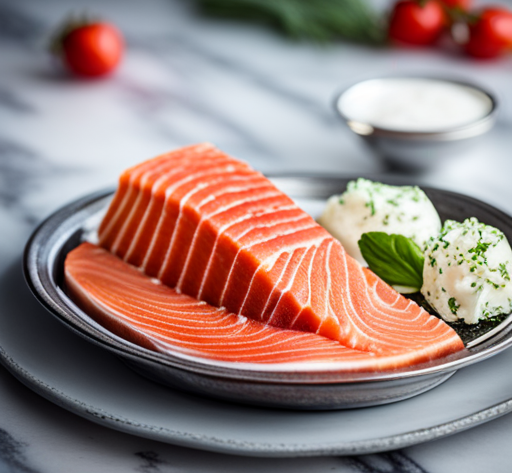If you’ve ever wondered whether freezing salmon makes it safe to eat raw, you’re not alone. In this article, we’ll delve into the impact of freezing on salmon safety, exploring how it reduces parasites and affects texture and flavor.
We’ll also discuss the importance of proper freezing techniques and offer best practices for thawing and handling frozen salmon for raw consumption.
By the end, you’ll have a better understanding of whether freezing can make raw salmon safe to eat.
Key Takeaways
- Freezing reduces the risk of bacterial contamination in salmon.
- Freezing kills or renders parasites inactive in salmon, making it safe to eat raw.
- Proper freezing methods preserve the texture and flavor of salmon.
- Thawing methods such as refrigerator thawing and cold water thawing are crucial to prevent bacterial growth and maintain the integrity of the fish.
The Impact of Freezing on Salmon Safety
Freezing salmon significantly reduces the risk of bacterial contamination. When salmon is frozen, the low temperatures inhibit the growth of bacteria, making it safer to consume raw or partially cooked. The freezing process slows down the metabolic activity of bacteria, preventing them from multiplying and causing foodborne illnesses.
However, it’s important to note that freezing doesn’t completely eliminate bacteria; it only reduces their numbers. To maintain the quality of frozen salmon, it’s crucial to freeze it as quickly as possible after catching or purchasing. The shorter the freezing time, the better the texture and flavor of the salmon will be when thawed.
It’s also recommended to store frozen salmon at temperatures below 0°F (-18°C) to ensure its safety and quality.
Understanding the Role of Freezing in Parasite Reduction
To ensure the safety of your raw salmon, freezing significantly reduces the risk of parasite contamination. Freezing salmon is an effective method for preventing the transmission of parasites that can be present in raw fish. By subjecting the fish to freezing temperatures, parasites are killed or rendered inactive, making the salmon safer to consume raw. The freezing process works by reducing the temperature to levels that are inhospitable for parasites to survive. Different freezing methods can be employed, such as blast freezing or freezing at -4°F (-20°C) for at least 7 days. These methods ensure that any potential parasites present in the salmon are destroyed or made harmless. By understanding the role of freezing in parasite reduction, you can enjoy raw salmon with peace of mind.
| Freezing Method | Temperature | Duration |
|---|---|---|
| Blast Freezing | -31°F (-35°C) | 24 hours |
| -4°F (-20°C) | -4°F (-20°C) | 7 days |
| -31°F (-35°C) | -31°F (-35°C) | 15 hours |
| -40°F (-40°C) | -40°F (-40°C) | 48 hours |
| -58°F (-50°C) | -58°F (-50°C) | 20 hours |
Examining the Effects of Freezing on Salmon Texture and Flavor
To fully understand the effects of freezing on salmon texture and flavor, you should consider its impact on the overall eating experience. Freezing methods can have varying effects on the quality of salmon.
When frozen properly, the texture of salmon can remain firm and the flavor can be preserved. However, if salmon is frozen and thawed incorrectly, it can result in a loss of moisture and a mushy texture.
The freezing process can also affect the flavor of salmon, with some people reporting a slight change in taste compared to fresh salmon.
It’s important to note that freezing can alter the texture and flavor of salmon to some extent, but with proper freezing methods and careful thawing, the overall eating experience can still be enjoyable.
The Importance of Proper Freezing Techniques for Raw Salmon Consumption
When properly freezing raw salmon, you should ensure that the technique used maintains its safety for consumption. Freezing salmon is an effective method to kill parasites and reduce the risk of foodborne illnesses.
To ensure the quality and safety of raw salmon, here are three important freezing methods to consider:
-
Flash freezing: This involves freezing the salmon at extremely low temperatures (-40 to -80 degrees Celsius) for a short period. Flash freezing preserves the texture and flavor of the salmon while preventing the growth of harmful bacteria.
-
Vacuum sealing: Vacuum sealing removes air from the packaging, preventing freezer burn and maintaining the quality of the salmon. It also prevents cross-contamination from other foods in the freezer.
-
Proper storage temperature: It’s crucial to store the frozen salmon at or below 0 degrees Celsius to maintain its safety and quality. The freezer should be set to the coldest temperature possible to prevent any thawing or spoilage.
Best Practices for Thawing and Handling Frozen Salmon for Raw Consumption
When handling frozen salmon for raw consumption, you should thaw it properly to ensure its safety and quality. Thawing salmon correctly is crucial to prevent the growth of harmful bacteria and maintain the integrity of the fish. Below are some best practices for thawing and handling frozen salmon:
| Thawing Technique | Description |
|---|---|
| Refrigerator Thawing | Place the frozen salmon in the refrigerator overnight or for about 24 hours. This slow thawing method allows for a gradual temperature change, minimizing the risk of bacterial growth. |
| Cold Water Thawing | Submerge the tightly sealed salmon in a bowl of cold water. Change the water every 30 minutes to ensure it stays cold. This method is faster than refrigerator thawing but requires more attention. |
| Microwave Thawing | Use the defrost setting on your microwave to thaw the salmon. However, be cautious as this method can lead to uneven thawing and partial cooking. |
Frequently Asked Questions
How Long Should Salmon Be Frozen to Ensure It Is Safe to Eat Raw?
To ensure raw salmon is safe to eat, freeze it at -4°F (-20°C) for a minimum of 7 days. This optimal freezing time kills any potential parasites, making it safe for consumption.
Can Freezing Salmon Completely Eliminate All Parasites?
Freezing salmon can greatly reduce the risk of parasites, but it may not eliminate them completely. However, proper freezing techniques can make it safer to eat raw, while preserving its nutritional value.
Can Freezing Salmon Alter Its Nutritional Value?
Freezing salmon can alter its nutritional value, but the freezing technique used plays a crucial role. Some nutrients may be lost during the freezing process, but overall, freezing can help preserve the nutritional benefits of salmon.
Are There Any Specific Freezing Techniques That Should Be Avoided When Preparing Salmon for Raw Consumption?
To ensure the safety of raw salmon consumption, it is important to avoid certain freezing techniques. Freezing at temperatures below -4°F and for a minimum of 7 days can help reduce the risk of parasites.
Is It Necessary to Thaw Frozen Salmon Before Consuming It Raw?
It’s safe to eat raw frozen salmon. Freezing helps kill parasites and bacteria that could make you sick. However, fresh salmon may have a better texture and taste.
Conclusion
In conclusion, freezing salmon can indeed make it safe to eat raw. Freezing not only reduces the risk of parasites present in raw fish, but it also helps maintain the texture and flavor of the salmon.
However, it’s crucial to follow proper freezing techniques and handle frozen salmon correctly to ensure its safety for raw consumption. By thawing and handling frozen salmon with care, you can enjoy the benefits of this delicious and nutritious seafood delicacy.




